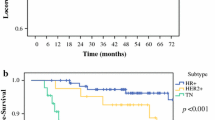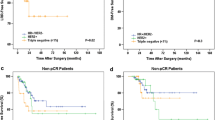Abstract
Background
Our group previously published data showing that patients could be stratified by constructed molecular subtype with respect to locoregional recurrence (LRR)-free survival after neoadjuvant chemotherapy and breast-conserving therapy (BCT). That study predated use of trastuzumab for human epidermal growth factor receptor 2 (HER2)-positive patients. The current study was undertaken to determine the impact of subtype and response to therapy in a contemporary cohort.
Methods
Clinicopathologic data from 751 breast cancer patients who received neoadjuvant chemotherapy (with trastuzumab if HER2+) and BCT from 2005 to 2012 were identified. Hormone receptor (HR) and HER2 status were used to construct molecular subtypes: HR+/HER2− (n = 369), HR+/HER2+ (n = 105), HR−/HER2+ (n = 58), and HR−/HER2− (n = 219). Actuarial rates of LRR were determined by the Kaplan–Meier method and compared by the log-rank test. Multivariate analysis was performed to determine factors associated with LRR.
Results
The pathologic complete response (pCR) rates by subtype were as follows: 16.5 % (HR+/HER2−), 45.7 % (HR+/HER2+), 72.4 % (HR−/HER2+), and 42.0 % (HR−/HER2−) (P < 0.001). Median follow-up was 4.6 years. The 5-year LRR-free survival rate for all patients was 95.4 %. Five-year LRR-free survival rates by subtype were 97.2 % (HR+/HER2−), 96.1 % (HR+/HER2+), 94.4 % (HR−/HER2+), and 93.4 % (HR−/HER2−) (P = 0.44). For patients with HR−/HER2+ disease, the LRR-free survival rates were 97.4 and 86.7 % for those who did and those who did not experience pCR, respectively. For patients with HR−/HER2− disease, the LRR-free survival rates were 98.6 % (pCR) versus 89.9 % (no pCR). On multivariate analysis, the HR−/HER2− subtype, clinical stage III disease, and failure to experience a pCR were associated with LRR.
Conclusions
Patients undergoing BCT after neoadjuvant chemotherapy have excellent rates of 5-year LRR-free survival that are affected by molecular subtype and by response to neoadjuvant chemotherapy.


Similar content being viewed by others
References
Cortazar P, Zhang L, Untch M, Mehta K, Costantino JP, Wolmark N, et al. Pathological complete response and long-term clinical benefit in breast cancer: the CTNeoBC pooled analysis. Lancet. 2014;384(9938):164–72.
Dowsett M, Dunbier AK. Emerging biomarkers and new understanding of traditional markers in personalized therapy for breast cancer. Clin Cancer Res. 2008;14:8019–26.
Faneyte IF, Schrama JG, Peterse JL, Remijnse PL, Rodenhuis S, van de Vijver MJ. Breast cancer response to neoadjuvant chemotherapy: predictive markers and relation with outcome. Br J Cancer. 2003;88:406–12.
Guarneri V, Broglio K, Kau SW, Cristofanilli M, Buzdar AU, Valero V, et al. Prognostic value of pathologic complete response after primary chemotherapy in relation to hormone receptor status and other factors. J Clin Oncol. 2006;24:1037–44.
Caudle AS, Yu TK, Tucker SL, Bedrosian I, Litton JK, Gonzalez-Angulo AM, et al. Local-regional control according to surrogate markers of breast cancer subtypes and response to neoadjuvant chemotherapy in breast cancer patients undergoing breast conserving therapy. Breast Cancer Res. 2012;14:R83.
Mamounas EP, Anderson SJ, Dignam JJ, Bear HD, Julian TB, Geyer CE Jr., et al. Predictors of locoregional recurrence after neoadjuvant chemotherapy: results from combined analysis of National Surgical Adjuvant Breast and Bowel Project B-18 and B-27. J Clin Oncol. 2012;30:3960–6.
Buzdar AU, Ibrahim NK, Francis D, Booser DJ, Thomas ES, Theriault RL, et al. Significantly higher pathologic complete remission rate after neoadjuvant therapy with trastuzumab, paclitaxel, and epirubicin chemotherapy: results of a randomized trial in human epidermal growth factor receptor 2-positive operable breast cancer. J Clin Oncol. 2005;23:3676–85.
Mittendorf EA, Wu Y, Scaltriti M, Meric-Bernstam F, Hunt KK, Dawood S, et al. Loss of HER2 amplification following trastuzumab-based neoadjuvant systemic therapy and survival outcomes. Clin Cancer Res. 2009;15:7381–8.
Untch M, Fasching PA, Konecny GE, Hasmüller S, Lebeau A, Kreienberg R, et al. Pathologic complete response after neoadjuvant chemotherapy plus trastuzumab predicts favorable survival in human epidermal growth factor receptor 2–overexpressing breast cancer: results from the TECHNO trial of the AGO and GBG study groups. J Clin Oncol. 2011;29:3351–7.
Kim MM, Allen P, Gonzalez-Angulo AM, Woodward WA, Meric-Bernstam F, Buzdar AU, et al. Pathologic complete response to neoadjuvant chemotherapy with trastuzumab predicts for improved survival in women with HER2-overexpressing breast cancer. Ann Oncol. 2013;24:1999–2004.
Krishnamurthy S, Sneige N, Bedi DG, Edieken BS, Fornage BD, Kuerer HM, et al. Role of ultrasound-guided fine-needle aspiration of indeterminate and suspicious axillary lymph nodes in the initial staging of breast carcinoma. Cancer. 2002;95:982–8.
Hammond ME, Hayes DF, Dowsett M, Allred DC, Hagerty KL, Badve S, et al. American Society of Clinical Oncology/College of American Pathologists guideline recommendations for immunohistochemical testing of estrogen and progesterone receptors in breast cancer. J Clin Oncol. 2010;28:2784–95.
Hoffman KE, Mittendorf EA, Buchholz TA. Optimising radiation treatment decisions for patients who receive neoadjuvant chemotherapy and mastectomy. Lancet Oncol. 2012;13:e270–6.
Peterson DJ, Truong PT, Sadek BT, Alexander CS, Wiksyk B, Shenouda M, et al. Locoregional recurrence and survival outcomes by type of local therapy and trastuzumab use among women with node-negative, HER2-positive breast cancer. Ann Surg Oncol. 2014;21:3490–6.
Seal MD, Speers CH, O’Reilly S, Gelmon KA, Ellard SL, Chia SK. Outcomes of women with early-stage breast cancer receiving adjuvant trastuzumab. Curr Oncol. 2012;19:197–201.
McArthur HL, Mahoney KM, Morris PG, Patil S, Jacks LM, Howard J, et al. Adjuvant trastuzumab with chemotherapy is effective in women with small, node-negative, HER2-positive breast cancer. Cancer. 2011;117:5461–8.
Kiess AP, McArthur HL, Mahoney K, Patil S, Morris PG, Ho A, et al. Adjuvant trastuzumab reduces locoregional recurrence in women who receive breast-conservation therapy for lymph node-negative, human epidermal growth factor receptor 2–positive breast cancer. Cancer. 2012;118:1982–8.
Arsenault D, Hurley J, Takita C, Reis IM, Zhao W, Rodgers S, et al. Predictors of locoregional outcome in HER2-overexpressing breast cancer treated with neoadjuvant chemotherapy. Am J Clin Oncol. 2015;38:348–52.
Mittendorf EA, Buchholz TA, Tucker SL, Meric-Bernstam F, Kuerer HM, Gonzalez-Angulo AM, et al. Impact of chemotherapy sequencing on local-regional failure risk in breast cancer patients undergoing breast-conserving therapy. Ann Surg. 2013;257:173–9.
Jeruss JS, Mittendorf EA, Tucker SL, Gonzalez-Angulo AM, Buchholz TA, Sahin AA, et al. Combined use of clinical and pathologic staging variables to define outcomes for breast cancer patients treated with neoadjuvant therapy. J Clin Oncol. 2008;26:246–52.
Mittendorf EA, Jeruss JS, Tucker SL, et al. Validation of a novel staging system for disease-specific survival in patients with breast cancer treated with neoadjuvant chemotherapy. J Clin Oncol. 2011;29:1956–62.
Vila J, Teshome M, Tucker SL, et al. Combining clinical and pathologic staging variables has prognostic value in predicting local-regional recurrence following neoadjuvant chemotherapy for breast cancer. Ann Surg. In press.
Cancello G, Maisonneuve P, Rotmensz N, Viale G, Mastropasqua MG, Pruneri G, et al. Prognosis in women with small (T1mic,T1a,T1b) node-negative operable breast cancer by immunohistochemically selected subtypes. Breast Cancer Res Treat. 2011;127:713–20.
Huang EH, Tucker SL, Strom EA, McNeese MD, Kuerer HM, Hortobagyi GN, et al. Predictors of locoregional recurrence in patients with locally advanced breast cancer treated with neoadjuvant chemotherapy, mastectomy, and radiotherapy. Int J Radiat Oncol Biol Phys. 2005;62:351–7.
Hunt KK, Ballman KV, McCall LM, Boughey JC, Mittendorf EA, Cox CE, et al. Factors associated with local-regional recurrence after a negative sentinel node dissection: results of the ACOSOG Z0010 trial. Ann Surg. 2012;256:428–36.
Wright JL, Takita C, Reis IM, Zhao W, Saigal K, Wolfson A, et al. Predictors of locoregional outcome in patients receiving neoadjuvant therapy and postmastectomy radiation. Cancer. 2013;119:16–25.
Arvold ND, Taghian AG, Niemierko A, Abi Raad RF, Sreedhara M, Nguyen PL, et al. Age, breast cancer subtype approximation, and local recurrence after breast-conserving therapy. J Clin Oncol. 2011;29:3885–91.
Mamounas EP, Tang G, Fisher B, Paik S, Shak S, Costantino JP, et al. Association between the 21-gene recurrence score assay and risk of locoregional recurrence in node-negative, estrogen receptor–positive breast cancer: results from NSABP B-14 and NSABP B-20. J Clin Oncol. 2010;28:1677–83.
Liedtke C, Mazouni C, Hess KR, André F, Tordai A, Mejia JA, et al. Response to neoadjuvant therapy and long-term survival in patients with triple-negative breast cancer. J Clin Oncol. 2008;26:1275–81.
Acknowledgment
The University of Texas MD Anderson Cancer Center is supported in part by a Cancer Center Support grant (CA016672) from the National Institutes of Health. J.V. is supported by a grant from the Carlos III Health Institute. B.S. is supported by a grant from the Cancer Prevention and Research Institute of Texas (RP140020). E.M. is an R. Lee Clark Fellow of The University of Texas MD Anderson Cancer Center supported by the Jeanne F. Shelby Scholarship Fund.
Disclosure
The authors declare no conflict of interest.
Author information
Authors and Affiliations
Corresponding author
Rights and permissions
About this article
Cite this article
Swisher, S.K., Vila, J., Tucker, S.L. et al. Locoregional Control According to Breast Cancer Subtype and Response to Neoadjuvant Chemotherapy in Breast Cancer Patients Undergoing Breast-conserving Therapy. Ann Surg Oncol 23, 749–756 (2016). https://doi.org/10.1245/s10434-015-4921-5
Received:
Published:
Issue Date:
DOI: https://doi.org/10.1245/s10434-015-4921-5




